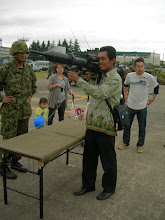SYUTSUJIN
after the syutsujin ceremony has been performed at each of the Myoken Jinja, Taisho gives the order for the Shutsujin. Upon the sign from Jingai (a shell blown at the start) and the flag, the Shutsujin gets under way
Shutsujin/Soma City and Minami Soma City (Haramachi-ku and Odaka-ku)
The Shutsujin takes place at each of the Soma Nakamura Jinja, Soma Ota Jinja and Soma Odaka Jinja. After praying and bottoms up, the preparation is complete and the Taisho gives the order for the Shutsujin. Upon the sign from soldiers furihata, the Kaikyaku loudly blows the kai, and the Shutsujin gets under way
Soutaishou-Omukae /Minami Soma city (Kashima-ku)
Arround 100 Kitagosei samurais come to meet the general Taisho on a Nagata, Join up with the Utagosei, form a procession and head to wards the kitagojinya to meet the general Taisho. As the meeting of the general Taisho ceremony is based on the old ceremony, there is a noticeable tension around the Kitago Jinja as the message from the general Taisho is relayed in detail by the hayauma.
When the general meeting of the Taisho ceremony is finished, the Utago and the Kitagosei troops head towards the Hibarigahara-Saijochi
Yoinorikeiba/Minami soma city (Haramachi-ku)
At 2 o`clock in the afternoon at the Hibarigahara Saijochi, After the Babakiyome ceremony and on the blowing of the jinggai by the kaiyaku, samurais wearing old style riding gear of white headband, jinbaori and nohakama take part in the yoinorikeiba, consisting of 12 laps of 1000 meters each
OGYORETSU
All the marches and signals are conducted by the traditional jingai and jindaiko. The army of 500 plus samurais majestically approaches the Gohonjin
At 9:30 in the morning, when the Jingai - Jindaiko ring out and the fireworks from the cannon split the air, the samurais who have gathered around the Ogawa Bridge in the north of haramachi-ku head off to Hibarigahara Saijouji (3 km). First with the Nakanogo (Haramachi-ku)force, which at the Soma Oota Jinja, at head, The Odakago (Odaka-ku), the Shinehago (Namie Machi, Futaba machi, Ookuma machi) follow, in the Shingari come the Kitago (Kashima-ku), Nakamura Jinja, march towards the Gohonjin.
Clad in the Kachu passed down from their ancestors, the sight of the 500 plus samurais lined up in a majestic, spectacular battle scene is a truly incomparable highlight, not finished.
KACCHU KEIBA
The traditional kacchu keiba, where man and horse race as one through a could of dust, bringing to life a battle scene of samurais brave and bold.
At noon, when the Jingai - Jindaiko ring out, the young warriors remove their kabuto and tighten their white hachimaki, flying the ancestral hatasashimono, rideing horse in the otsuboryu and man and horse fly through the wind as one as the Kachukeiba starts.
The sound of the flags fluttering in the wind, the sound of the armour and kusasuri clanging together, the sound of the hooves kicking up the earth. A harmony of noise running through a cloud of dust. A scene of power and emotion. The Kacchu - Keiba consists of 10 horses running 10 laps of 1000 meters. passion
data from www.city.minamisoma.lg.jp




Tidak ada komentar:
Posting Komentar